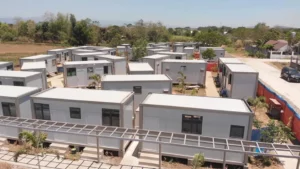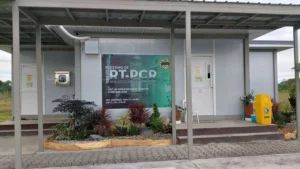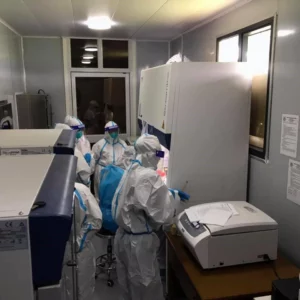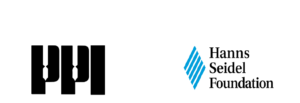TABUK CITY, Kalinga – This component city was able to set the standards in the effective and efficient response of local government against the COVID-19 with the establishment of the first local government funded and operated molecular laboratory that contributed in speeding up the turn around time in the release of swab test results that were vital in the implementation of strategic measures to prevent the rapid spread of the virus.

At the start of the COVID-19 pandemic and the implementation of the series of lockdowns to contain the rapid spread of the virus, the health department and local governments were confronted with a serious problem on how to immediately detect the prevalence of cases with only the State-managed Research Institute of Tropical Medicine (RITM) based in Metro Manila performing the real-time reverse transcription polymerase chain reaction (RT-PCR) confirmatory tests on the swab samples of suspected patients.

The turn around time in the release of the results of the RT-PCR confirmatory tests performed by the RITM was around 5-7 days with the suspected patient required to undergo facility-based quarantine while awaiting the results of the said tests. Most individuals who were subjected to the RT-PCR confirmatory test reportedly suffered from anxiety and other mental issues because of the long wait on the swab test results.
Subsequently, the health department worked out the establishment of the initial 5 sub-national testing centers to help speed up the turn around time in the release of swab test results which was from 3-4 days then. However, health workers and local officials who were managing the situation on the ground were not yet satisfied on the slight reduction on the turn around time that prompted them to look for other workable strategies that will help in addressing the pressing concern of people subjected to the RT-PCR confirmatory test.
On April 7, 2020, the health department issued Administrative Order (AO) No. 2020-0014 setting the standards in licensing COVID -19 laboratories as a strategy to expand testing capacity, have more capable laboratories, and at the same time, ensure that quality and safety are maintained.
“We had to look for other strategies on how we will be able to speed up the release of swab test results for us to be able to enhance our COVID-19 response efforts. We had to work on our limits while providing our people with the needed assistance to cope up with the situation, Mayor Darwin C. Estran֮ero stressed.
Under previous health protocols, individuals who were swabbed and their close contacts are mandated to undergo quarantine while awaiting the results of their confirmatory tests that have caused them to allegedly suffer from anxiety and other mental issues.
Upon consultation with concerned sectors of the city, the local government decided to invest part of the city’s Bayanihan grant augmented by realigned funds from the local government to complete the P15 million required to put up the city-funded, owned and operated molecular laboratory to be able to easily release the confirmatory test results of swab samples not only from the city but also from the 7 towns of Kalinga and nearby towns of provinces in the Cagayan Valley.

During the said period, the whole province and the city had been experiencing a surge in cases with the dreaded Delta variant posing a serious threat to the lives of those who contracted severe infection.
Of the region’s 124,863 cases, Kalinga accounts for less than 10 percent of the said cases with a total of 12,183 cases. In terms of death, Kalinga and Tabuk City also account for less than 10 percent of the recorded COVID-related deaths with 259 out of the 2,693 reported deaths in the region over the past 2 years.
Mayor Estran֮ero narrated that during the initial surge in cases, swab samples from the city and the province were not prioritized in a health department-operated molecular laboratory in nearby Tuguegarao City, Cagayan that is why Baguio City was always the final destination of the swab samples needing confirmatory tests from the city and the province.
Further, he claimed that there were also instances when assigned drivers of vehicles tasked to deliver the swab test results to the Baguio General Hospital and Medical Center (BGHMC) for confirmatory tests backed out of their task for fear of being exposed and eventually contract the virus and compromise the health condition of their family members.
For her part, City Health Officer Dr. Henrietta S. Bagayao stated that even with the stringent requirements for its establishment and manpower requirements, the Tabuk City Covid-19 RT-PCR Testing laboratory was established and is renowned and dubbed as the First LGU Funded Covid-19 Testing Laboratory in Northern Philippines if not the whole country.
She claimed that having a laboratory owned, operated and maintained by the city and catering not only to Tabukenos but also to all municipalities in the province and even nearby provinces is a giant step in its COVID response mechanism specifically on the pillar of detection.
More importantly, testing turnaround time has been reduced significantly to 24 hours or less. The reduced turnaround time has greatly improved the diagnosis and immediate treatment and isolation of patients. This is one of the best practices the CHSO have achieved in the pandemic that had a very great impact on the city, province and even nearby provinces in Region 2 and CAR.
The city health officer disclosed that health workers and medical technologists assigned to operate the RT-PCR and automated extractions machines underwent rigid trainings under the supervision of the RITM until they were issued the required certificates as competent individuals to operate the said machines that will facilitate the timely release of the confirmatory test results.

“We are lucky to have visionary leaders who are fully aware of the urgent needs of the people during difficult times. We also salute our health workers and barangay officials who are always at the frontline during trying times for us to be able to cope up with the situation,” Dra. Bagayao stated.
The city’s molecular laboratory was issued the license to operate by the health department on June 6, 2021 and no less than Health /Assistant Secretary Narciso Santiago lauded the decision of the local government to put up its own molecular laboratory that will be useful in detecting other similar life-threatening viruses.
Many local and health officials from various local government units started to benchmark on the success of Tabuk City in the put up of its own molecular laboratory that paved the way for the subsequent establishment of similar local government funded and operated laboratories in various parts of the country. To date, 46 out of the 350 operating molecular laboratories are owned by local governments.
Tabuk is a component city of Kalinga which was established by virtue of Republic Act (RA) 9404 that was ratified by the people of the city on June 24, 2007. It is considered to be the third largest city in the country with a land area of more or less 700.25 square kilometers with agriculture as the main source of income of the populace earning its title as the rice granary of the Cordillera.
The city’s molecular laboratory is able to perform some 600 tests depending on the availability of the swab samples that will brought to the said facility for the conduct of confirmatory tests to allow people to be able to travel to their desired destinations that require them to present their negative swab test results, especially in foreign countries that continue to implement stricter border controls to prevent the rapid spread of the virus in their places.
Aside from the established BGHMC sub-national testing laboratory, the other established molecular laboratories in Tuguegarao City, Cagayan; Ilagan City, Isabela, Dagupan City, Pangasinan; Luis Hora Regional Memorial Hospital in Bauko, Mountain Province; and other regional hospitals are all under the jurisdiction of the health department. On the other hand, the molecular laboratory at the Benguet General Hospital in La Trinidad, Benguet was funded under the initiative of Benguet Rep. Eric Yap.
While it is true that there are 2 local government owned and operated molecular laboratories in the Cordillera, the case of Tabuk City is unique because the funding for the project was primarily sourced from available local funds compared to the case of the Benguet General Hospital (BeGH) is totally different because the source of funds was from the initiative of Congressman Yap and that its operation is undertaken by the hospital staff.
Actually, the city’s molecular laboratory was ready for operation early 2021 but its projected full blast operation was delayed by the rescheduled inspection by RITM experts on the procured units of equipment, the conduct of trainings by the RITM of the personnel who will be manning the operation of the laboratory among other reasons.
Tabuk was able to demonstrate sound fiscal management by allowing the wise use of part of its Bayanihan grant and part of its available funds to establish a molecular laboratory that will serve its purpose for some time thereby besting other highly urbanized cities which had bigger share from the government’s Bayanihan grant during the pandemic.
However, the local government did not only rely on the put up of its own molecular laboratory as it also decided to establish its own unique temporary treatment and monitoring facility (TTMF) within a city-owned property in barangay Agbannawag to cater to the quarantine and isolation needs of suspected and probable COVID-19 patients.
The 120-bed zone-type city owned and operated isolation facility was designed to cater to the recovery needs of patients who are confined in the facility to complete their quarantine or isolation requirements based on the assessment of health authorities. Each of the isolation rooms which were made from container vans has its own comfort room, bed and bedside table, television set and air conditioning unit which is likened to a hotel room. Initially, the isolation facility had a total of 56 pre-fabricated container vans with 2 rooms each.
Moreover, some of the container vans are also being used as treatment or conference rooms, nurses stations, power supply rooms, and personnel quarters.
To compliment the project, the Cordillera office of the Department of Public Works and Highways (DPWH-CAR) also constructed a 20-bed capacity isolation facility which is primarily composed of container vans beside the city’s TTMF which was known as the Tabuk city TTMF.
Bagayao underscored that the 120-bed TTMF played a key role in the prevention of further transmission of the deadly virus where the same was manned by experienced doctors, nurses, midwives, nursing aides, utility workers and security personnel which were hired by the local government aside from the augmentation from the health department.
According to her, their service at the TTMF is in addition to their regular functions as health care workers attending to the needs of both sick and health people from the city’s 43 barangays amidst the surge in cases and work overloads but local health workers preferred to walk the extra mile wholeheartedly rendering round the clock duties at the TTMF.
The city-owned and managed TTMF was designed to have a park outside the facility so that when patients look out of their window, they can see for themselves fresh flowers appropriately designed to help in removing their anxiety and other mental issues that confront them, thus, serving its purpose for them to be able to easily recover during their prescribed quarantine or isolation period.
Estran֮ero pointed out that the very purpose in the decision to immediately put up a city-owned and operated molecular laboratory was for the health and safety of everyone and that the local government is inclined to maximize the use of its limited resources to be able to address the effects of the pandemic and make it easier for health workers to detect infected individuals who will be immediately subjected to quarantine or isolation depending on their diagnosis.
Many travelers said that the operation of the city-owned molecular laboratory was timely because the release of the swab test results was done several hours after the conduct of the swab that is why they were able to immediately travel to their desired destinations to attend to important engagements because of the availability of their negative RT-PCR test.
As to their future uses once the pandemic will be over, the local government intends to fully equip the molecular laboratory to be able to conduct tests for other viruses while the TTMF will be used as accommodation facility for visitors of the concerned government agencies and the city, especially when the existing hotels will be fully occupied during special occasions, among other beneficial uses.













